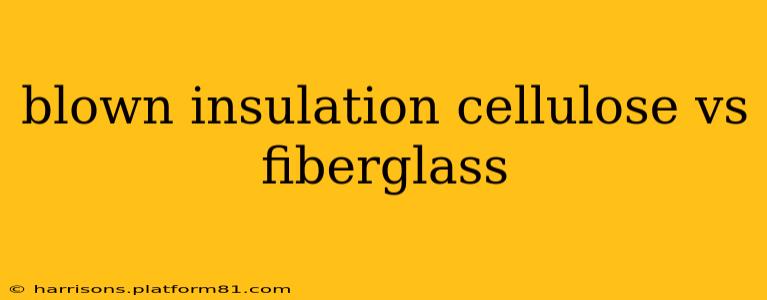Choosing the right insulation is crucial for a comfortable, energy-efficient home. Two popular options, blown cellulose and fiberglass, offer distinct advantages and disadvantages. This comprehensive guide will help you understand the key differences to make an informed decision for your home improvement project.
What is Blown-in Cellulose Insulation?
Blown-in cellulose insulation is a loose-fill material made primarily from recycled paper. It's treated with borates for fire resistance and pest deterrence. It's installed using specialized machinery that blows the fluffy material into wall cavities, attics, and other areas needing insulation. This method allows for excellent coverage, even in hard-to-reach places.
What is Fiberglass Insulation?
Fiberglass insulation comes in various forms, including batts, rolls, and blown-in insulation. It's made from glass fibers and is often treated with a binder to hold the fibers together. Batts and rolls are easier to install yourself, while blown-in fiberglass offers similar application benefits to cellulose. Both types are widely available and relatively inexpensive.
Blown Cellulose vs. Fiberglass: Key Differences
Here's a breakdown of the key differences between blown cellulose and fiberglass insulation:
R-Value:
- Cellulose: Offers a high R-value per inch, typically around R-3.7 to R-3.8 per inch. This means it provides excellent thermal resistance, keeping your home warmer in winter and cooler in summer.
- Fiberglass: Provides a slightly lower R-value, generally around R-3.1 to R-3.8 per inch, depending on the density and type.
Installation:
- Cellulose: Requires specialized equipment and is best installed by professionals for optimal results and even distribution.
- Fiberglass: Batts and rolls are DIY-friendly, while blown-in fiberglass necessitates professional installation similar to cellulose.
Cost:
- Cellulose: Generally more expensive upfront due to the need for professional installation and potentially higher material costs depending on location and availability of recycled materials.
- Fiberglass: Usually less expensive initially, particularly for batts and rolls that can be self-installed.
Environmental Impact:
- Cellulose: Considered a more environmentally friendly option because it’s made from recycled paper, reducing landfill waste and lowering the embodied carbon associated with its manufacturing.
- Fiberglass: Has a higher embodied carbon footprint due to its manufacturing process involving energy-intensive glass production. However, it's widely recyclable.
Moisture Resistance:
- Cellulose: Can absorb moisture, potentially leading to mold growth if not properly installed and protected from water intrusion.
- Fiberglass: Generally less prone to moisture absorption but can still be affected by excessive moisture.
Air Sealing:
- Cellulose: Its loose-fill nature helps to seal air gaps and cracks, improving overall energy efficiency.
- Fiberglass: Can be less effective at air sealing, particularly batts and rolls, unless carefully installed with attention to gaps.
Which Insulation is Right for Me?
The best choice depends on your specific needs and priorities.
- Choose cellulose if: You prioritize environmental friendliness, high R-value, and excellent air sealing. Budget is a secondary concern, and you're comfortable with professional installation.
- Choose fiberglass if: You're on a tighter budget, prefer a DIY approach (for batts and rolls), and need a readily available option.
Frequently Asked Questions (FAQs)
Is blown cellulose insulation itchy?
No, blown-in cellulose insulation is not itchy. The recycled paper fibers are much less irritating than fiberglass fibers.
Does cellulose insulation attract rodents?
While cellulose insulation is treated with borates to deter pests, proper installation and sealing are crucial to prevent rodent infestations. Any gaps or openings should be sealed to eliminate potential entry points.
How long does blown cellulose insulation last?
With proper installation and maintenance, blown cellulose insulation can last for several decades.
Is fiberglass insulation flammable?
Fiberglass insulation itself is not flammable, but it can act as a conduit for flames. It's important to adhere to fire codes and consider additional fire safety measures when installing.
Can I install blown-in cellulose myself?
While technically possible, it's strongly recommended to hire a professional for blown-in cellulose insulation. Improper installation can compromise energy efficiency, lead to moisture problems, and void warranties. The specialized equipment required also presents a safety risk to untrained individuals.
This comparison should provide a solid foundation for your decision. Remember to consult with qualified insulation professionals to determine the best option for your specific home and climate. They can assess your needs and provide a tailored recommendation based on your budget and energy efficiency goals.
